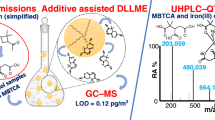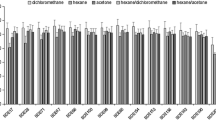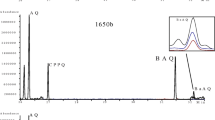Abstract
Goal, scope, and background
Diesel exhaust is believed to consist of thousands of organic constituents and is a major cause of urban pollution. We recently reported that a systematic separation procedure involving successive solvent extractions, followed by repeated column chromatography, resulted in the isolation of vasodilatory active nitrophenols. These findings indicated that the estimation of the amount of nitrophenols in the environment is important to evaluate their effect on human health. The isolation procedure, however, involved successive solvent extractions followed by tedious, repeated chromatography, resulting in poor fractionation and in a significant loss of accuracy and reliability. Therefore, it was crucial to develop an alternative, efficient, and reliable analytical method. Here, we describe a facile and efficient acid-base extraction procedure for the analysis of nitrophenols.
Materials and methods
Diesel exhaust particles (DEP) were collected from the exhaust of a 4JB1-type engine (ISUZU Automobile Co., Tokyo, Japan). Gas chromatography–mass spectrometry (GC–MS) analysis was performed with a GCMS-QP2010 instrument (Shimadzu, Kyoto, Japan).
Results
A solution of DEP in 1-butanol was extracted with aqueous NaOH to afford a nitrophenol-rich oily extract. The resulting oil was methylated with trimethylsilyldiazomethane and subsequently subjected to GC–MS analysis, revealing that 4-nitrophenol, 3-methyl-4-nitrophenol, 2-methyl-4-nitrophenol, and 4-nitro-3-phenylphenol were present in significantly higher concentrations than those reported previously.
Discussion
Simple acid-base extraction followed by the direct analysis of the resulting extract by GC–MS gave only broad peaks of nitrophenols with a poor detection limit, while the GC–MS analysis of the sample pretreated with (trimethylsilyl)diazomethane gave satisfactorily clear chromatograms with sharp peaks and with a significantly lowered detection limit (0.5 ng/ml, approximately 100 times).
Conclusion
The present method involving an acid-base extraction, in situ derivatization, and GC–MS analysis has shown to be a simple, efficient, and reliable method for the isolation and identification of the chemical substances in DEP.
Similar content being viewed by others
References
Bayona JM, Markides KE, Lee M (1988) Characterization of polar polycyclic aromatic compounds in a heavy-duty diesel exhaust particulate by capillary column gas chromatography and high-resolution mass spectrometry. Environ Sci Technol 22:1440–1447
Draper WM (1986) Quantitation of nitro- and dinitropolycyclic aromatic hydrocarbons in diesel exhaust particulate matter. Chemosphere 15:437–447
Erdinger L, Durr M, Hopker KA (2005) Correlations between mutagenic activity of organic extracts of airborne particulate matter, NOx, and sulphur dioxide in southern Germany—results of a two-year study. Env Sci Pollut Res 12:10–20
Furuta C, Suzuki AK, Taneda S, Kamata K, Hayashi H, Mori Y, Li C, Watanabe G, Taya K (2004) Estrogenic activities of nitrophenols in diesel exhaust particles. Biol Report 70:1527–1533
Furuta C, Li CM, Taneda S, Suzuki AK, Kamata K, Watanabe G, Taya K (2005) Immunohistological study for estrogenic activities of nitrophenols in diesel exhaust particles. Endocrine 27:33–36
Hayatsu M, Hirano M, Tokuda S (2000) Involvement of two plasmids in fenitrothion degradation by Burkholderia sp. strain NF100. Appl Environ Microbiol 66:1737–1740
Ichinose T, Yajima Y, Nagashima M, Takenoshita S, Nagamachi Y, Sagai M (1997) Lung carcinogenesis and formation of 8-hydroxy-deoxyguanosine in mice by diesel exhaust particles. Carcinogenesis 18:185–192
Kim TS, Kim JK, Choi K, Stenstrom MK, Zoh KD (2006) Degradation mechanism and the toxicity assessment in TiO2 photocatalysis and photolysis of parathion. Chemosphere 62:926–933
Li CM, Takahashi S, Taneda S, Furuta C, Watanabe G, Suzuki AK, Taya K (2006a) Impairment of testicular function in adult male Japanese quail (Coturnix japonica) after a single administration of 3-methyl-4-nitrophenol in diesel exhaust particles. J Endocrinol 189:555–564
Li CM, Taneda S, Suzuki AK, Furuta C, Watanabe G, Taya K (2006b) Anti-androgenic activity of 3-methyl-4-nitrophenol in diesel exhaust particles. Eur J Pharmacol 543:194–199
Li CM, Taneda S, Suzuki AK, Furuta C, Watanabe G, Taya K (2006c) Estrogenic and anti-androgenic activities of 4-nitrophenol in diesel exhaust particles. Toxicol Appl Pharmacol 217:1–6
Li CM, Taneda S, Suzuki AK, Furuta C, Watanabe G, Taya K (2006d) Effects of 3-methyl-4-nitrophenol in diesel exhaust particles on the regulation of testicular function in immature male rats. J Androl 28:252–258
McClellan RO (1987) Health effects of exposure to diesel exhaust particles. Annu Rev Pharmacol Toxicol 27:279–300
Mestres R (2005) Green chemistry—views and strategies. Env Sci Pollut Res 12:128–132
Miyabara Y, Ichinose T, Takano H, Lim HB, Sagai M (1998) Effects of diesel exhaust on allergic airway inflammation in mice. J Allergy Clin Immunol 102:805–812
Mori Y, Kamata K, Toda N, Hayashi H, Seki K, Taneda S, Yoshino S, Sakushima A, Sakata M, Suzuki AK (2003) Isolation of nitrophenols from diesel exhaust particles (DEP) as vasodilatation compounds. Biol Pharm Bull 26:394–395
Morville S, Scheyer A, Mirabel P, Millet M (2006) Spatial and geographical variations of urban, suburban and rural atmospheric concentrations of phenols and nitrophenols. Env Sci Pollut Res 13:83–89
Muranaka M, Suzuki S, Koizumi K, Takafuji S, Miyamoto T, Ikemori R, Tokiwa H (1986) Adjuvant activity of diesel-exhaust particulates for the production of IgE antibody in mice. J Allergy Clin Immunol 77:616–623
Ona LF, Melinda A, Alberto P, Prudente JA, Sigua GC (2006) Levels of lead in urban soils from selected cities in a central region of the Philippines. Env Sci Pollut Res 13:177–183
Sagai M, Saito H, Ichinose T, Kodama M, Mori Y (1993) Biological effects of diesel exhaust particles. I. In vitro production of superoxide and in vivo toxicity in mouse. Free Radical Biol Med 14:37–47
Sagai M, Furuyama A, Ichinose T (1996) Biological effects of diesel exhaust particles (DEP). III. Pathogenesis of asthma like symptoms in mice. Free Radical Biol Med 21:199–209
Schuetzle D (1983) Sampling of vehicle emissions for chemical analysis and biological testing. Environ Health Perspect 47:65–80
Schuetzle D, Lewtas J (1986) Bioassay-directed chemical analysis in environmental research. Anal Chem 58:1060A–1075A
Seidel B, Alm M, Peters R, Kordell W, Schaffer A (2006) Safety evaluation for a biodiesel process using prion-contaminated animal fat as a source. Env Sci Pollut Res 13:125–130
Takafuji S, Suzuki S, Koizumi K, Tadokoro K, Miyamoto T, Ikemori R, Muranaka M (1987) Diesel-exhaust particulates inoculated by the intranasal route have an adjuvant activity for IgE production in mice. J Allergy Clin Immunol 79:639–645
Taneda S, Kamata K, Hayashi H, Toda N, Seki K, Sakushima A, Yoshino S, Yamaki K, Sakata M, Mori Y, Suzuki AK (2004a) Investigation of vasodilatory substances in diesel exhaust particles (DEP) Isolation and identification of nitrophenol derivatives. J Health Sci 50:133–141
Taneda S, Mori Y, Kamata K, Hayashi H, Furuta C, Li C, Seki K, Sakushima A, Yoshino S, Yamaki K, Watanabe G, Taya K, Suzuki AK (2004b) Estrogenic and anti-androgenic activity of nitrophenols in diesel exhaust particles (DEP). Biol Pharm Bull 27:835–837
Tsukue N, Toda N, Tsubone H, Sagai M, Jin WZ, Watanabe G, Taya K, Birumachi J, Suzuki AK (2001) Diesel exhaust (DE) affects the regulation of testicular function in male Fischer 344 rats. J Toxicol Environ Health A 63:115–126
Tsukue N, Toda N, Sagai M, Watanabe G, Taya K, Tsubone H, Suzuki AK (2002) Diesel exhaust particulate extract (DEPE)-induced abnormal parturition associated with increased myometrial contractility in C57BL mice. Environ Sci 9:355–367
Watanabe N, Oonuki Y (1999) Inhalation of diesel engine exhaust affects spermatogenesis in growing male rats. Environ Health Perspect 107:539–544
Yoshida S, Sagai M, Oshio S, Umeda T, Ihara T, Sugamata M, Sugawara I, Takeda K (1999) Exposure to diesel exhaust affects the male reproductive system of mice. Int J Androl 22:307–315
Acknowledgement
This study was supported in part by a grant from the Japan Society for the Promotion of Science (Basic Research C-17510052).
Author information
Authors and Affiliations
Corresponding author
Rights and permissions
About this article
Cite this article
Noya, Y., Mikami, Y., Taneda, S. et al. Improvement of an efficient separation method for chemicals in diesel exhaust particles: analysis for nitrophenols. Environ Sci Pollut Res 15, 318–321 (2008). https://doi.org/10.1007/s11356-008-0006-3
Received:
Accepted:
Published:
Issue Date:
DOI: https://doi.org/10.1007/s11356-008-0006-3




